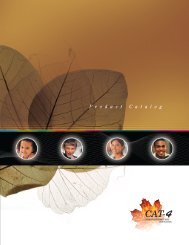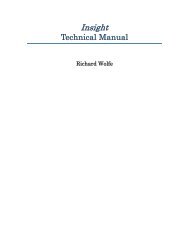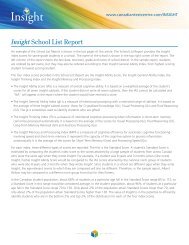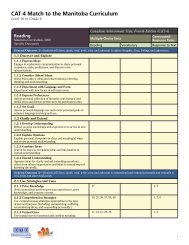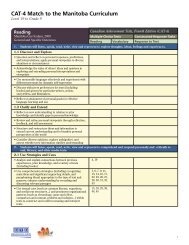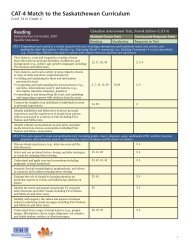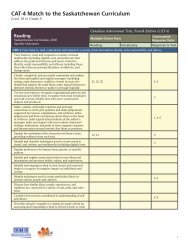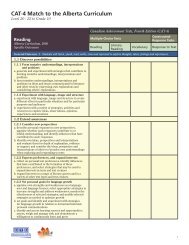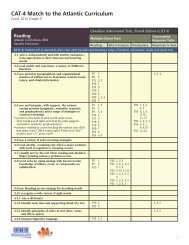CATâ4 Match to the Alberta Curriculum - Canadian Test Centre
CATâ4 Match to the Alberta Curriculum - Canadian Test Centre
CATâ4 Match to the Alberta Curriculum - Canadian Test Centre
You also want an ePaper? Increase the reach of your titles
YUMPU automatically turns print PDFs into web optimized ePapers that Google loves.
CAT∙4 <strong>Match</strong> <strong>to</strong> <strong>the</strong> <strong>Alberta</strong> <strong>Curriculum</strong><br />
Level 20 - 22 <strong>to</strong> Grade 11<br />
Reading<br />
<strong>Alberta</strong> <strong>Curriculum</strong>, 2000<br />
Specific Outcomes<br />
<strong>Canadian</strong> Achievement <strong>Test</strong>s, Fourth Edition (CAT·4)<br />
Multiple-Choice <strong>Test</strong>s<br />
Reading<br />
Literary<br />
Reading<br />
Vocabulary<br />
Constructed-<br />
Response Tasks<br />
Response <strong>to</strong> Text<br />
General Outcome 2 - Students will listen, speak, read, write, view and represent <strong>to</strong> comprehend literature and o<strong>the</strong>r texts in oral, print,<br />
visual and multimedia forms, and respond personally, critically and creatively.<br />
2.1 Construct meaning from text and context<br />
2.1.1 Discern and analyze context<br />
a. describe <strong>the</strong> text crea<strong>to</strong>r’s purpose, and analyze <strong>the</strong> target<br />
audience<br />
b. describe how societal forces can influence <strong>the</strong> production<br />
of texts<br />
c. explain <strong>the</strong> relationship between text and context in<br />
terms of how elements in an environment can affect <strong>the</strong><br />
way in which a text is created<br />
d. identify <strong>the</strong> impact that personal context—experience,<br />
prior knowledge—has on constructing meaning from a<br />
text<br />
2.1.2 Understand and interpret content<br />
a. use a variety of strategies <strong>to</strong> comprehend literature and<br />
o<strong>the</strong>r texts and develop strategies for close reading of<br />
literature in order <strong>to</strong> understand contextual elements<br />
b. describe how supporting ideas and supporting details<br />
streng<strong>the</strong>n a text’s controlling idea<br />
c. describe <strong>the</strong> relationships among plot, setting, character,<br />
atmosphere and <strong>the</strong>me when studying a narrative<br />
d. compare <strong>the</strong> personality traits, roles, relationships,<br />
motivations, attitudes, values and archetypal qualities,<br />
when appropriate, of characters developed/persons<br />
presented in literature and o<strong>the</strong>r texts<br />
e. describe a text crea<strong>to</strong>r’s <strong>to</strong>ne and register; and identify<br />
<strong>the</strong> moral and ethical stance communicated by a text<br />
f. interpret figurative language, symbol and allusions;<br />
recognize imagery; and explain how imagery contributes<br />
<strong>to</strong> atmosphere, characterization and <strong>the</strong>me in a text<br />
g. analyze visual and aural elements, and explain how <strong>the</strong>y<br />
contribute <strong>to</strong> <strong>the</strong> meaning of texts<br />
h. describe <strong>the</strong> relationship between audience response <strong>to</strong><br />
<strong>the</strong> content of a presentation and audience response <strong>to</strong><br />
<strong>the</strong> performance of <strong>the</strong> presenter<br />
2.1.3 Engage prior knowledge<br />
a. reflect on and describe strategies used <strong>to</strong> engage prior<br />
knowledge as a means of assisting comprehension of new<br />
texts; and select, moni<strong>to</strong>r and modify strategies as needed<br />
b. assess personal expectations for texts <strong>to</strong> be studied in<br />
light of prior experiences with and observations about<br />
similar contexts, content and text forms<br />
c. use metacognitive strategies <strong>to</strong> understand how<br />
knowledge of rhe<strong>to</strong>rical devices, textual elements and<br />
structures used in previously studied texts contributes <strong>to</strong><br />
understanding new texts<br />
d. classify <strong>the</strong> genre/form of new texts according <strong>to</strong><br />
attributes of genres/forms previously studied<br />
20<br />
1, 2, 4, 6, 7, 9,<br />
11, 13, 16, 25,<br />
26, 28, 33, 36,<br />
38<br />
2, 4, 6, 9, 13,<br />
14, 15, 18, 19,<br />
20, 26, 27, 29,<br />
31, 32, 33, 35,<br />
36, 37, 39<br />
14, 15, 16, 17,<br />
18, 19, 20, 21,<br />
22, 23, 24, 25,<br />
26, 27, 28, 29,<br />
30<br />
2



